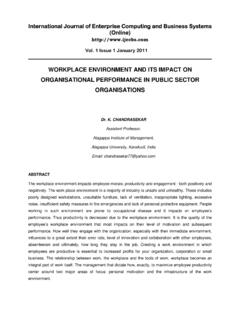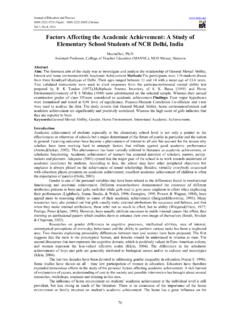Transcription of Obsessive-Compulsive Disorder: Diagnosis and Management
1 896 American Family Physician Volume 92, Number 10 November 15, 2015 Obsessive-Compulsive disorder (OCD) is a chronic illness that can cause marked distress and disability. It is a complex disorder with a variety of manifestations and symptom dimensions, some of which are underrecognized. Early recogni-tion and treatment with OCD-specific therapies may improve outcomes, but there is often a delay in Diagnosis . Patients can experience significant improvement with treatment, and some may achieve remission. Recommended first-line therapies are cognitive behavior therapy, specifically exposure and response prevention, and/or a selective serotonin reuptake inhibitor (SSRI). Patients with OCD require higher SSRI dosages than for other indications, and the treatment response time is typically longer.
2 When effective, long-term treatment with an SSRI is a reasonable option to prevent relapse. Patients with severe symptoms or lack of response to first-line therapies should be referred to a psychiatrist. There are a variety of options for treatment-resistant OCD, including clomipramine or augmenting an SSRI with an atypical antipsychotic. Patients with OCD should be closely monitored for psychiatric comorbidities and suicidal ide-ation. (Am Fam Physician. 2015 ; 92 (10) :896-903. Copyright 2015 American Academy of Family Physicians.) Obsessive-Compulsive Disorder: Diagnosis and ManagementJILL N. FENSKE, MD, and KETTI PETERSEN, MD, University of Michigan Medical School, Ann Arbor, MichiganObsessive-compulsive disorder (OCD) is a neuropsychiatric dis-order characterized by recurrent distressing thoughts and repeti-tive behaviors or mental rituals performed to reduce anxiety.
3 Symptoms are often accom-panied by feelings of shame and secrecy. In addition, health care professionals do not always recognize the diverse manifestations of OCD. These factors often lead to a long delay in Diagnosis . The average time it takes to receive treatment after meeting diagnostic criteria for OCD is 11 Primary care physicians can play a crucial role in reducing the burden of OCD through early detection and lifetime prevalence of OCD is ,2 although this may be an underrepresentation because often only patients with moderate to severe symptoms seek help. The mean age of onset is years, and it is rare for new cases of OCD to develop after the early A sub-set of patients, mostly males, have an early onset (before 10 years of age).
4 The lifetime risk of developing OCD is higher in females, who typically develop the disorder in of IllnessOCD has a substantial effect on quality of life and level of It is often a chronic disorder (60% to 70% of cases) and is likely to persist if not treated ,4 Significant improvement or remission is possible when evidence-based therapies are applied. Patients with a later age of onset, shorter duration of symptoms, good insight, and response to initial treatment have an increased likelihood of Early and aggressive treatment of OCD, with a goal of remission, is important for a positive Therefore, it is critical that primary care physicians are equipped to diagnose and treat patients with OCD appropriately. Insufficient treatment and a lack of OCD-specific resources are important problems in the Management of this disorder.
5 In one study population, only of patients with severe symptoms and of patients with moderately severe symptoms received treatment specific for This clinical content conforms to AAFP criteria for continuing medical education (CME). See CME Quiz Questions on page disclosure: No rel-evant financial affiliations. Patient information: A handout on this topic is available at http://family doctor/en/diseases- IS NEW ON THIS TOPIC: OCDIn the Diagnostic and Statistical Manual of Mental Disorders, 5th ed., OCD is recognized as a disorder distinct from motivational interviewing may increase engagement with cognitive behavior therapy for OCD and improve its = Obsessive-Compulsive from the American Family Physician website at Copyright 2015 American Academy of Family Physicians. For the private, noncom-mercial use of one individual user of the website.
6 All other rights reserved. Contact for copyright questions and/or permission DisorderNovember 15, 2015 Volume 92, Number 10 American Family Physician 897 PathogenesisThe pathogenesis of OCD is a complex interplay between neurobiology, genetics, and environmental influences. Historically, dysfunction in the serotonin system was postulated to be the main factor in OCD pathogenesis, given the selective response to serotonergic medication. More recent research has also demonstrated the role of glutamate, dopamine, and possibly other A proposed model for OCD suggests that genetic vulnerability to environmental stressors may result in modification of gene expression within neurotransmit-ter systems. This, in turn, results in changes to brain cir-cuitry and are recurrent intrusive thoughts or images that cause marked distress.
7 The thoughts are unwanted and inconsistent with the individual s sense of self (ego-dystonic), and great effort is made to resist or suppress them. They can involve contamination; repeated doubts; or taboo thoughts of a sexual, religious, or aggressive nature. Compulsions are repetitive behaviors or mental rituals performed to counteract the anxiety caused by obsessions. Individuals feel strongly compelled to com-plete these actions, and the behaviors become automatic over time. They can include handwashing, checking, ordering, praying, counting, and seeking reassurance. Common obsessions and compulsions are included in Ta b l e the Diagnostic and Statistical Manual of Mental Dis-orders, 5th ed., OCD is recognized as a disorder distinct from anxiety (Ta b l e 2) and is now grouped with several other disorders with common features, often referred to as Obsessive-Compulsive related disorders (Ta b l e 3).
8 10 OCD is a complex, heterogeneous disorder, and some presenta-tions are underrecognized. For example, taboo thoughts may be attributed to other causes or may not appear to be associated with overt compulsions. Even when compul-sions are not easily observable, patients with OCD usually have mental rituals. Patients are often reluctant to report symptoms of OCD for a variety of reasons, including embarrassment, stigma, and the fear of what the obsession might mean or the consequences of revealing Physicians should consider the possibility of OCD in patients with general complaints of anxiety or depres-sion. Patients may offer clues by alluding to intrusive thoughts or repetitive behaviors. Avoidance of particular locations or objects, excessive concerns about illness or injury, and repetitive reassurance-seeking behavior are also common.
9 It is important to note that Obsessive-Compulsive personality disorder is a separate diagnos-tic entity that is not characterized by intrusive thoughts or repetitive behaviors. Rather, it is a pervasive pattern of behaviors emphasizing organization, perfectionism, and a sense of If true OCD is suspected, the use of a few simple screening questions can be helpful (Ta b l e 4).12 Standardized diagnostic tools are available, but most are not practical for use in primary care. Two Table 1. Common Symptoms in Patients with Obsessive-Compulsive DisorderObsessionExamplesAssociated compulsive behaviorsAggressiveFear of harming others, recurrent violent imagesMonitoring the news for reports of violent crimes, asking for reassurance about being a good personContaminationFear of being contaminated or contaminating others; fear of being contaminated by germs, infections, or environmental factors.
10 Fear of being contaminated by bad or immoral personsWashing or cleaning ritualsPathologic doubt, completeness Recurrent worries about doing things incorrectly or incompletely, thereby negatively affecting the patient or othersChecking excessively, performing actions in a particular orderReligiousThoughts about being immoral and eternal damnationAsking forgiveness, praying, reassurance seekingSelf-control Fear of making inappropriate comments in publicAvoiding being around othersSexualRecurrent thoughts about being a pedophile or sexually deviant; recurrent thoughts about acting sexually inappropriate toward othersAvoiding situations that trigger the thoughts, performing mental rituals to counteract the thoughts Superstition Fears of certain bad numbers or colorsCounting excessivelySymmetry and exactnessRecurrent thoughts of needing to do things in a balanced or exact fashionOrdering and arrangingAdapted with permission from Grant JE.














